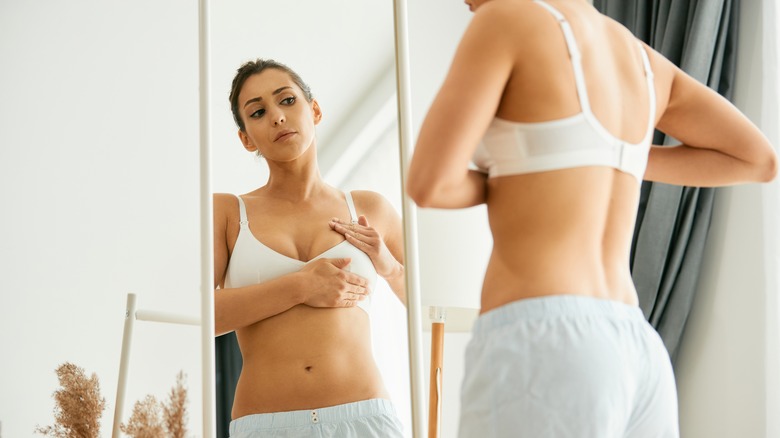Why You Probably Don't Have To Worry If Your Nipples Change Colors
Women have them, men have them, and Harry Styles apparently has four of them. Yup, pretty much everyone possesses nipples. They're part of what makes us, well, human. If there's one thing to know about nipples, though, it's that they come in various shapes, sizes, and colors. And despite the existence of "standard" nipples (as in the type you see in the media), no two nipples are the same. "This is no different than the various shapes of eyes or colors of eyes from person to person," surgical oncologist Dr. Susan Hoover told Self.
You may even be confused as to what a nipple really is. The nipple is the protruding bump in the middle of your breast, while the skin surrounding it is the areola. And the white bumps peppered mostly on your areola? They're called Montgomery glands (not to be confused with mammary).
Your nipples change over the course of your lifetime, especially when you undergo hormonal changes and pregnancy. And while it can be concerning that your nipples shift in colors through the years, it may actually not be something to feel anxious about. More often than not, a change in nipple color is normal.
Nipples change in color throughout your lifetime
There was once a time when medical professionals assessed a woman's health through the color of their nipples (per Healthline), but it's actually more complicated than that. Generally, its shade is dependent on your race, just like your skin, hair, and eye color. "Nipple color is not indicative of health in any way," Dr. Debra Patt, a medical oncologist and breast cancer specialist, explained to Self. "There's natural variability in nipple color, just as there is in skin tone variability with — and within — different ethnicities."
The color changes throughout different phases of your life, too. Dr. Heather Irobunda, a New York City-based OB-GYN, shared with Well + Good that they can get darker when you get older or when your hormone level change, like during pregnancy or when you're on birth control. "Oftentimes, when nipple color changes, it may stay that new color," she added. "If your nipples became darker during pregnancy, they may return to their previous color, but it may take a while for them to do so."
Your nipple color may also change when you tan, or when you experience hyperkeratosis, a condition where there is an increased thickness of the outer layer of the skin. It's normally harmless and doesn't usually warrant a trip to your dermatologist.
How to know if something's up
It's normal to feel worried when changes occur in your nipple area, but Dr. Irobunda told Well + Good that the only time you should consult a health professional is when you experience nipple pain in addition to the color change. Then again, pain is also normal, especially if you're breastfeeding. "She may notice that her nipples may become irritated when she initially starts. This is due to the friction that is caused initially when a baby starts to breastfeed," Dr. Irobunda added. "This constant friction and suction on the nipple can cause chafing, cracking, itching, or soreness of the nipple."
Most cyclical breast pain goes away on its own or through over-the-counter medication, but Healthline notes that if it doesn't, and if it's linked to other symptoms like fever, weird discharge, painful lumps, and other things you don't normally experience, then there's no harm in getting your breasts checked out. Additionally, if nothing is found, Dr. Holly Pederson, a breast health specialist, advises making a lifestyle change. "If diagnostic tests such as ultrasound are normal, usually nothing further needs to be done," she shared with Cleveland Clinic. "We often recommend conservative steps first, such as cutting out caffeine, to see if symptoms improve."


